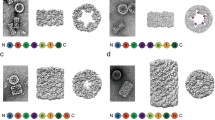Summary
-
1.
Fluorescence (F) of the hemocyanin ofEurypelma californicum is strongly dependent on the degree of oxygenation (Fig. 2). Maximum excitation is found at 292 to 294 nm. There is only a small shift of maximum emission from 345 nm in oxygenated to 350 nm in deoxygenated hemocyanin, indicating that mainly tryptophan is responsible for oxygenation-dependent fluorescence (Fig. 3). Fluorescence enhancement depends linearly on the degree of deoxygenation (Fdeoxy/Foxy is about 16 at pH 7.4; Fig. 4).
-
2.
Based on fluorescence quenching upon oxygenation, a fluorimetric-polarographic method for recording oxygen equilibrium curves was developed: With a favourable geometrical arrangement and low hemocyanin concentration, the error induced by reabsorption of emitted light is minimal (working range 0.02–0.2 mg/ml, corresponding to ca. 0.005–0.05 O.D. at 340 nm; Fig. 5). Data obtained by this method are in excellent agreement with data obtained by photometry (Figs. 6 and 7).
-
3.
Oxygen affinity and cooperativity between oxygen binding sites ofEurypelma hemocyanin are strongly modified by protons: There is a very pronounced Bohr effect with a maximum between pH 8.0 and 8.4 (ΔlogP 50/ΔpH=−1.2; Fig. 7). Cooperativity is maximal at about pH 8.0 (n 50=7) and decreases towards low and high pH (Fig. 7). Oxygen affinity is independent of hemocyanin concentration, cooperativity, however, is slightly increased at high hemocyanin concentration.
-
4.
Modification of oxygen affinity and cooperativity is interpreted in the framework of the Monod, Wyman and Changeux (1965) model. SinceK Tass andK Rass could not be estimated directly from the Hill plots, the intrinsic association constants of the first and the last oxygenation step,K 1 andK 24, were determined by means of a modified Scatchard plot (Edsall et al., 1954);K 1=0.0036 mm Hg−1=0.0022×106 M−1;K 24=2.69 mm Hg−1=1.636×106 M−1. With [T 0]≫[R 0],K 1 representsK Tass , whereasK 24 ([T 0]≪[R 0]) is equal toK Rass . From these constants, the MWC parameterc was calculated to be 0.00133 (c=K1/K24). The total free energy of interaction, ΔF 1, is 3.9 kcal/site (25°C).
Similar content being viewed by others
References
Adair, G.S.: The hemoglobin system. VI. The oxygen dissociation curve of hemoglobin. J. Biol. Chem.63, 529–545 (1925)
Antonini, E., Rossi-Fanelli, A., Caputo, A.: Studies on chlorocruorin I. The oxygen equilibrium ofSpirographis chlorocruorin. Arch. Biochem. Biophys.97, 336–342 (1962)
Bannister, W.H., Wood, E.J.: Ultraviolet fluorescence ofMurex trunculus haemocyanin in relation to the binding of copper and oxygen. Comp. Biochem. Physiol.40B, 7–18 (1971)
Brouwer, M., Bonaventura, C., Bonaventura, J.: Oxygen binding byLimulus polyphemus hemocyanin: Allosteric modulation by chloride ions. Biochemistry16, 3897–3902 (1977)
Buc, H., Johannes, K.-J., Hess, B.: Appendix to: Allosteric kinetics of pyruvate kinase ofSaccharomyces carlsbergensis (by Johannes, K.-J., Hess, B.). J. Mol. Biol.76, 199–205 (1973)
Colosimo, A., Brunori, M., Wyman, J.: Concerted changes in an allosteric macromolecule. Biophys. Chem.2, 338–344 (1974)
Edsall, J.T., Felsenfeld, G., Goodman, D.S., Gurd, F.R.N.: The association of imidazole with the ions of zinc and cupric copper. J. Am. Chem. Soc.76, 3054–3058 (1954)
Er-El, Z., Shaklai, N., Daniel, E.: Oxygen binding properties of haemocyanin fromLevantina hierosolina. J. Mol. Biol.64, 341–351 (1972)
Imai, K., Morimoto, H., Kotani, M., Watari, H., Hirata, W., Kuroda, M.: Studies on the function of abnormal hemoglobins. I. An improved method for automatic measurement of the oxygen equilibrium curve of hemoglobin. Biochim. Biophys. Acta200, 189–196 (1970)
Klarman, A., Shaklai, N., Daniel, E.: Tyrosyl fluorescence in hemocyanin from the scorpionLeiurus quinquestriatus. Biochim. Biophys. Acta490, 322–330 (1977)
Kuiper, H.A., Antonini, E., Brunori, M.: Kinetic control of cooperativity in the oxygen binding ofPanulirus interruptus hemocyanin. J. Mol. Biol.115, 4–8 (1977)
Loewe, R., Linzen, B.: Haemocyanins in spiders. I. Subunits and stability region ofDugesiella californica haemocyanin. Hoppe-Seyler's Z. Physiol. Chem.354, 182–188 (1973)
Loewe, R., Linzen, B.: Haemocyanins in spiders. II. Automatic recording of oxygen binding curves, and the effect of Mg++ on oxygen affinity, cooperativity, and subunit association ofCupienius salei haemocyanin. J. comp. Physiol.98, 147–156 (1975)
Long, C.: Biochemists' handbook, p. 33. London E. and F. Spon Ltd. 1961
Lowry, O.H., Rosebrough, N.J., Farr, A.L., Randall, R.J.: Protein measurement with the Folin phenol reagent. J. Biol. Chem.193, 265–275 (1951)
Markl, J., Schmid, R., Czichos-Tiedt, S., Linzen, B.: Haemocyanins in spiders, III. Chemical and physical properties of the proteins inDugesiella andCupienius blood. Hoppe-Seyler's Z. Physiol. Chem.354, 1713–1725 (1976)
Miller, K., Van Holde, K.E.: Oxygen binding byCallianassa californiensis hemocyanin. Biochemistry13, 1668–1674 (1974)
Monod, J., Wyman, J., Changeux, J.-P.: On the nature of allosteric transitions: A plausible model. J. Mol. Biol.12, 88–118 (1965)
Roxby, R., Miller, K., Blair, D.P., Van Holde, K.E.: Subunits and association equilibria ofCallianassa californiensis hemocyanin. Biochemistry13, 1662–1668 (1974)
Rubin, M.M., Changeux, J.-P.: On the nature of allosteric transitions: Implications of non-exclusive ligand binding. J. Mol. Biol.21, 265–274 (1966)
Schneider, H.-J., Markl, J., Schartau, W., Linzen, B.: Subunit heterogeneity ofEurypelma (Dugesiella) hemocyanin, and separation of polypeptide chains. Hoppe-Seyler's Z. Physiol. Chem.358, 1133–1141 (1977)
Shaklai, N., Daniel, E.: Fluorescence properties of hemocyanin fromLevantina hierosolima. Biochemistry13, 564–568 (1970)
Van Driel, R.: Oxygen binding and subunit interactions inHelix pomatia hemocyanin. Biochemistry12, 2696–2698 (1973)
Weber, G.: Enumeration of components in complex systems by fluorescence spectrophotometry. Nature (Lond.)190, 27–29 (1961)
Wyman, J.: Reflections regarding hemoglobin. In: Oxygen affinity of hemoglobin and red cell acid base status. Proc. Alfred Benzon Symp. IV. Rorth, M., Astrup, P. (eds.), pp. 37–49. Copenhagen: Munksgaard 1972
Zolla, L., Kuiper, H.A., Vecchini, P., Antonini, E., Brunori, M.: Dissociation and oxygen binding behaviour of β-hemocyanin fromHelix pomatia. (in press) (1978)
Author information
Authors and Affiliations
Rights and permissions
About this article
Cite this article
Loewe, R. Hemocyanins in spiders. J Comp Physiol B 128, 161–168 (1978). https://doi.org/10.1007/BF00689480
Accepted:
Issue Date:
DOI: https://doi.org/10.1007/BF00689480




